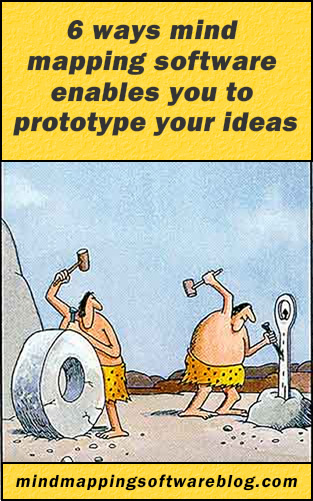 Many companies build physical prototypes of products, so they can “fail fast,” learn from them and iteratively improve their creations. Mind mapping software enables you to create and refine “prototypes” of your ideas.
Many companies build physical prototypes of products, so they can “fail fast,” learn from them and iteratively improve their creations. Mind mapping software enables you to create and refine “prototypes” of your ideas.
According to Peter Sims, author of Small Bets: How Breakthrough Ideas Emerge from Small Discoveries, prototypes are essential to the development of many new products and services, because they make our thinking tangible and enable us to experiment and improve upon our creations:
“The use of prototypes, often the rougher the better, greatly facilitates overcoming the blank page problem,” he explains. “At the beginning of any new idea, the possibilities can seem infinite, and that wide-open landscape of opportunity can become a prison of anxiety and self-doubt… Prototyping is one of the most effective ways to both jumpstart our thinking and to guide, inspire and discipline and experimental approach.”
As Sims points out, at this early stage you cannot be wedded to your ideas. You must be willing to modify, rethink and even abandon them as conditions merit. “Finding ways to fail quickly, to invest less emotion and less time in any particular idea or prototype or piece of work, is a consistent feature of the work methods of successful experimental innovators,” he explains.
Mind mapping software: THE platform for prototyping your ideas
The capabilities of modern mind mapping software encourage experimentation. Here are some of the ways in which it helps us to “prototype” our ideas.
1. It makes your thinking tangible: Once your ideas are made explicit on screen, they can be considered and manipulated. You can re-organize, refine and add to them until they have the structure and content you want. Topics can be rearranged to make better sense. Missing details can be added. Extraneous information can be removed.
2. It allows you to think freely: Because mind mapping software gives you almost complete freedom of topic movement, you can do a “brain dump” of ideas. It enables you to quickly capture every idea, no matter how far-fetched, with little regard for where it belongs in the mind map’s structure. You can organize, prioritize and decide what to do with them later. This process is mentally liberating, and enables you to capture a greater “flow” of ideas, whether you’re brainstorming alone or with a small group.
3. It enables “what if” thinking: The complete freedom of movement of topics that mind mapping software allows enables you to play “what if” with your thoughts, moving them to a new position, assessing their new meaning there, and moving them back or using the undo command if it doesn’t improve the map.
4. It encourages “plussing” of ideas: In the world of creative thinking, plussing refers to the practice of building upon and improving ideas. The associative power of the mind map makes this easy. Whether you’re brainstorming alone or in a group, seeing ideas as topics on screen suggests additional ideas, as well as ways to improve existing ones. Often, your initial ideas are not ready for prime time. But through patient thinking, planning and improvement, they can be grown to the point where they have great value. Mind mapping software is a powerful canvas for doing this type of thinking, planning and creation.
With today’s web-based mind mapping tools, it’s possible to collaborate on a mind map, either simultaneously with your colleagues, or asynchronously – where each of you logs into the mind map and adds your ideas at a different time. This represents another form of plussing or idea improvement.
If you want to learn more about plussing, Sims discusses how Pixar employs it in his book.
5. “Park” ideas that don’t seem to fit: Once again, mind mapping software is totally up to the task. If you have some information in your map that you’re not sure what to do with, you can easily put it on it’s own branch in a “parking lot” or a floating topic and decide what to do with it later.
6. Incorporate feedback into the mind map: Part of the purpose of creating a prototype is to show it to customers or stakeholders and get their reactions. You can easily review a mind map with key decision-makers, walking them through your thinking process and even incorporating their ideas into the map in real time, during your discussion. Seeing your collective thinking evolve on screen is a powerful experience. At the end of the meeting, you can provide each person with a print-out of the final mind map, which incorporates your ideas and their feedback. From a product development and iteration standpoint, that’s powerful!

Leave a Reply